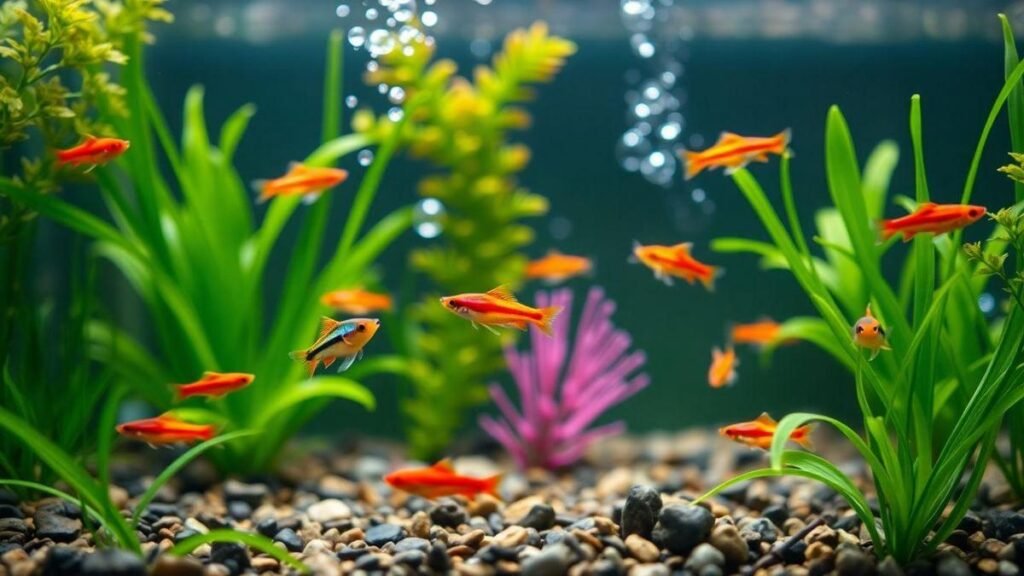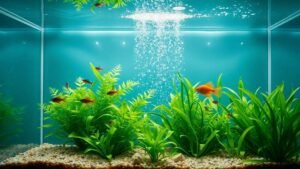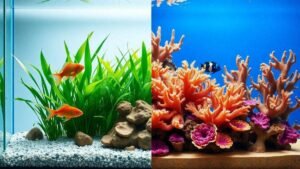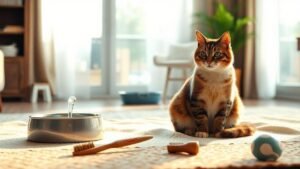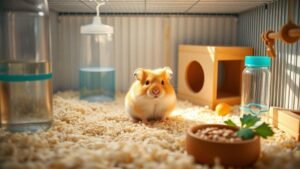Cuidados específicos para peixes de água doce e manutenção de aquários
I’m planning my freshwater tank and will walk you through calm, clear steps. I pick the right tank, stand, and lid for safety. I choose the right heater, light, and filter, lay down substrate and hiding places, and let the tank cycle before adding fish. I test pH, ammonia, nitrite, and nitrate weekly, watch temperature and hardness, feed a varied diet, quarantine new fish, care for plants, and keep a simple maintenance log so I can spot problems fast. These are the essential “Cuidados específicos para peixes de água doce e manutenção de aquários” to keep your tank stable and healthy. For a broader look at basic animal care, I also consult a broader pet care guide when planning the room layout and routines.
Key takeaway
- Do regular water changes to keep fish healthy; they help maintain a clean environment like the one described in strategies for keeping a pet environment comfortable.
- Test water to keep pH and ammonia safe.
- Pick fish that match in size and temperament.
- Keep filter and heater running for steady water.
- Feed small portions and remove leftovers; follow tips for keeping food and water areas clean and safe.
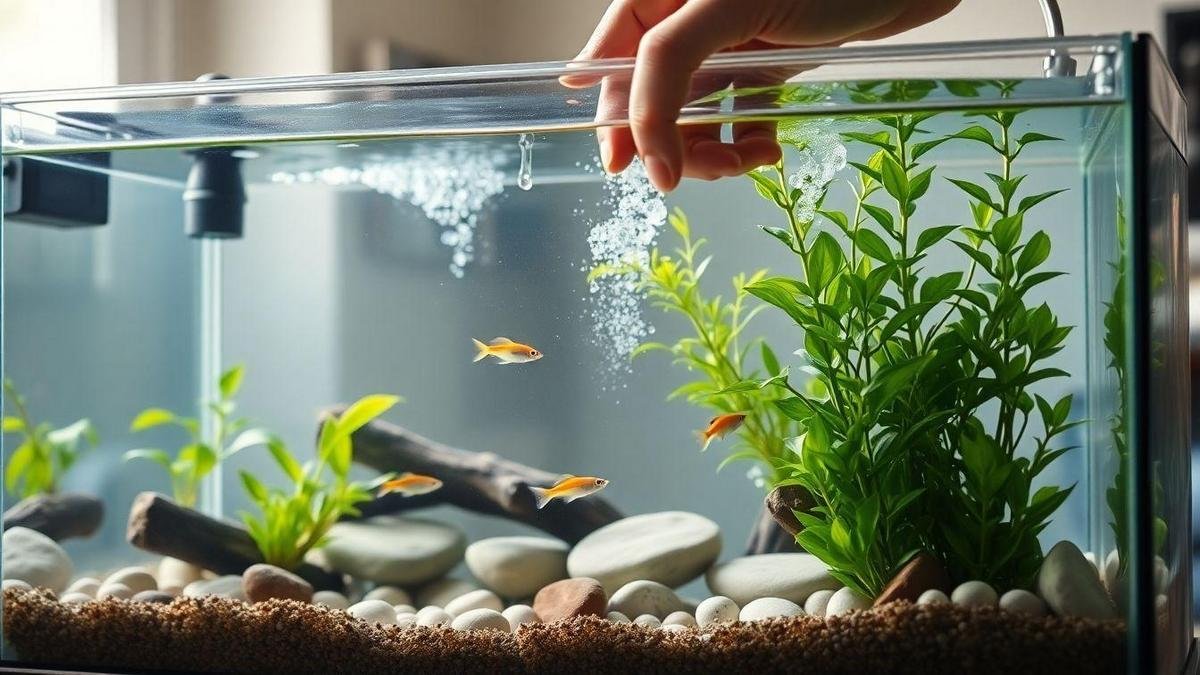
I pick the right tank size, stand, and lid
I choose a tank by thinking about fish size and number. I pick a bigger tank when I can—larger water volume is more stable. Match the stand to the tank weight and place it on a flat, level floor; consider general tips for designing a pet-friendly indoor space so the aquarium sits safely in the room. Use a lid to stop jumps and reduce evaporation; leave a small gap for cords and airflow.
| Tank size (L) | Good for | Stand note | Lid type |
|---|---|---|---|
| 20–40 | Small fish, shrimp | Light stand ok | Vented lid |
| 40–100 | Community fish | Sturdy stand | Hood with light |
| 100 | Larger species | Reinforced stand | Full hood, secure clips |
I choose heater, light, and filter rated for tank volume
Match equipment to the tank volume. A properly chosen heater and filter keeps water stable and clear.
- Heater: ~2–4 W per liter; place near the filter outlet for even heat.
- Filter: Rated for at least 4× tank volume/hour. More flow helps oxygenation and waste removal.
- Light: Match to plant and fish needs; brighter for demanding plants.
- Keep a small backup air pump or sponge filter for outages to protect fish during chores or maintenance—this is part of keeping pets safe during cleaning and chores.
| Equipment | Rule of thumb | Why it matters |
|---|---|---|
| Heater | 2–4 W per L | Keeps stable temperature |
| Filter | 4× tank volume/hr | Removes waste, oxygenates |
| Light | Match plant needs | Healthy plants and behaviors |
Layout: substrate, decor, and hiding places — then cycle
I add substrate first (light rinse), shape slopes for roots, place heavy decor on the substrate, and add hiding places for shy fish. Start the nitrogen cycle after decor is set so bacteria colonize surfaces.
I test daily during the cycle for ammonia, nitrite, and nitrate, and do small water changes if numbers spike. Keeping tools and the tank area tidy during this stage follows the same mindset as maintaining a clean home with pets without stress.
I monitor water quality — core Cuidados específicos para peixes de água doce e manutenção de aquários
I treat the tank like a small world that depends on me. Routine checks and steady actions are the foundation of “Cuidados específicos para peixes de água doce e manutenção de aquários.”
I test pH, ammonia, nitrite, and nitrate weekly
I use a liquid or strip kit weekly. If a value is off, I act calmly and deliberately.
| Parameter | Healthy range (common) | Action if high |
|---|---|---|
| pH | 6.5–7.5 (most tropical) | Small water change, buffer slowly |
| Ammonia (NH3/NH4) | 0 ppm | Large change, check filter & feeding |
| Nitrite (NO2-) | 0 ppm | Water change, add biological booster |
| Nitrate (NO3-) | < 40 ppm | Regular changes, reduce feeding |
- I write the numbers down in a maintenance log.
- I watch fish behavior after tests and make measured fixes.
Temperature and hardness: match species needs
I match temperature and hardness (GH) to the species and avoid sudden swings.
| Species example | Temp (°C) | GH (dGH) | Quick action if off |
|---|---|---|---|
| Tetras / Guppies | 24–26 | 4–12 | Adjust heater 0.5°C/day |
| Bettas | 25–27 | 3–10 | Slow water mix with conditioned water |
| Angelfish | 24–28 | 6–12 | 10–20% daily change until stable |
Practical tips:
- Use a reliable heater and external thermometer.
- Change water in small steps to fix hardness.
- Use RO or tap water with additives slowly and carefully.
I record results and adjust slowly—fast changes stress fish.
Filtration: mechanical, biological, chemical
I pick filter media to do three jobs: trap debris, host beneficial bacteria, and remove unwanted chemicals.
| Media type | Main function | Examples | Maintenance |
|---|---|---|---|
| Mechanical | Removes solids | Sponge, floss, filter pads | Rinse weekly in tank water |
| Biological | Houses beneficial bacteria | Ceramic rings, bio-balls | Rinse only in tank water; replace rarely |
| Chemical | Removes toxins/odors | Activated carbon, zeolite | Replace monthly or as needed |
Tips:
- Place mechanical before biological media in the flow.
- Never clean all biological media at once.
- Keep a spare of biological media to seed new filters.
If filter cleaning is part of your regular chores, follow safe routines so pets remain calm and the tank stays healthy—similar practices appear in guides about safe cleaning with pets in the home.
I cycle a new tank first (fishless or seeded)
I start a fishless cycle or use seeded media. Test ammonia, nitrite, and nitrate and add a source of ammonia.
| Step | What I do | What I watch |
|---|---|---|
| 1 | Add filter, heater, decor; add ammonia source | Ammonia rises |
| 2 | Test every 2–3 days | Ammonia drops, nitrite rises |
| 3 | Wait until nitrite drops and nitrate appears | Zero ammonia and nitrite |
| 4 | Partial water change and add a few fish slowly | Test daily first weeks |
I often use a piece of established sponge to jump-start beneficial bacteria. Cycling usually takes 2–6 weeks—patience protects the fish.
I choose fish carefully and feed them right
I match species, then feed smart. This reduces conflict and keeps water stable—key elements of Cuidados específicos para peixes de água doce e manutenção de aquários.
Match fish by size, temperament, and water needs
| Group | Size | Temperament | Water notes | Quick tip |
|---|---|---|---|---|
| Small schooling | Small | Peaceful | Softer, slightly acidic | Keep in groups of 6 |
| Small livebearers | Small | Peaceful to active | Neutral to slightly hard | Avoid slow-moving tankmates |
| Medium community | Medium | Mostly peaceful | Neutral pH, moderate hardness | Watch fin-nippers |
| Large or boisterous | Large | Semi-aggressive | Wider range | Give lots of space |
Quarantine new arrivals and add fish slowly.
Feed a varied diet and control portions
Variety keeps fish healthy and colorful.
- Types: rotate flakes, pellets, frozen, occasional live treats.
- Portions: feed what they finish in ~2 minutes.
- Schedule: once or twice daily; consider a weekly fasting day for many species.
- Store food in a cool, dry place and follow tips for keeping food and water areas safe.
Observe behavior daily to catch diet or compatibility issues early.
| Sign | What I think | Action |
|---|---|---|
| Loss of appetite | Diet or illness | Offer varied food; check water |
| Hiding or clamped fins | Stress or bullying | Add hiding spots or separate fish |
| Tail/fin damage | Nipping | Remove aggressor if needed |
| Gasping at surface | Low oxygen | Test water; add aeration |
Plants, substrate, and decor
I follow Cuidados específicos para peixes de água doce e manutenção de aquários when caring for plants—proper light, nutrients, and substrate make a huge difference.
Lighting and dosing
I run LED lights 6–8 hours/day for most tanks and adjust if algae appears. Dose macros (N, P, K) and micros (iron, trace elements) as needed.
| Goal | Light (hours/day) | Notes on dosing |
|---|---|---|
| Low-light (Anubias, Java fern) | 6 | Weekly micro dose; low macro |
| Medium-light (Crypts, Vallisneria) | 7 | Balanced macro micro twice weekly |
| High-light (carpets, stems) | 8 | Daily dosing; consider CO2 |
Too much light without nutrients invites algae—match light to dosing.
Substrate and safe decor
| Substrate | Best for | Tip |
|---|---|---|
| Aqua soil / plant substrate | Heavy root feeders | Add 2–3 cm base layer |
| Sand | Bottom-dwellers, thin roots | Use fine grain to avoid trapping waste |
| Gravel root tabs | Mixed tanks | Place root tabs near heavy feeders |
| Laterite | Iron boost for roots | Mix under sand or gravel |
Choose smooth decor; avoid sharp edges. Use aquarium-safe driftwood and rocks; anchor tall items.
Trim plants every 1–3 weeks, remove dead leaves, and vacuum substrate weekly. Replace 10–25% water regularly to keep nutrients steady.
Prevent disease and keep a water-change schedule
Cuidados específicos para peixes de água doce e manutenção de aquários centers on early detection and steady water quality.
Quarantine new fish
I quarantine new fish for ~14 days to catch signs like white spots, clamped fins, rapid breathing, loss of appetite, or lethargy. Test water in the quarantine tank and treat only if necessary. Helping new arrivals settle follows many of the same principles used to help pets adjust to a new indoor environment and to help pets feel safe and confident indoors.
| Action | Why it matters |
|---|---|
| Quarantine 14 days | Catches hidden illness before main tank |
| Daily observation | Spots early signs |
| Test water | Bad water can mimic disease |
| Treat only when needed | Avoids unnecessary stress |
A single quarantined fish can save the main tank.
Water-change schedule
I follow a simple plan:
- Lightly stocked: 25% weekly.
- Moderately stocked: 25–30% weekly.
- Heavily stocked or cloudy: 30–50% twice weekly.
Always vacuum the gravel, clean pre-filter sponges as needed, and replace with dechlorinated water close to tank temperature. Check ammonia, nitrite, and nitrate after changes.
Maintenance log
I keep a short, clear log with date, water change %, pH/ammonia/nitrite/nitrate, observations, and any treatments. Logs help spot trends so I can intervene before problems escalate.
| Field | What I record |
|---|---|
| Date | When I worked on the tank |
| Water change % | How much removed |
| pH / Ammonia / Nitrite / Nitrate | Quick numbers |
| Observations | Signs of illness or odd behavior |
| Medications / Actions | What I added or did |
Conclusion
With steady habits—choosing the right tank and equipment, cycling before adding fish, weekly tests, regular water changes, careful feeding, and a short maintenance log—you turn chaos into calm. These Cuidados específicos para peixes de água doce e manutenção de aquários are practical, repeatable steps that protect your fish and plants.
My aquarium is a small world that depends on consistent, patient care: quarantine new arrivals, protect beneficial bacteria, and treat plants and fish as partners, not projects. Little actions—rinsing a filter sponge in tank water or trimming a dying leaf—prevent bigger problems later. If you want a collection of related posts and practical ideas, see the site’s full list of posts or learn more about the authors.
For more practical help and ideas, visit: https://blogcraelo.com
Frequently asked questions
Q: What tank size should I start with for freshwater fish?
A: I recommend at least 20 gallons (≈75 L) for small community fish—bigger tanks give more stable water.
Q: How often should I test the water and do water changes?
A: I test weekly for ammonia, nitrite, nitrate, and pH. I do ~25% water change weekly (more if levels spike).
Q: What and how much should I feed my freshwater fish?
A: Feed small amounts once or twice daily—what they finish in about 2 minutes. Rotate flakes, pellets, frozen, and occasional live treats.
Q: How do I choose tankmates and plants that get along?
A: Match size, temperament, and water needs. Add plants and hiding spots and avoid mixes that stress each other.
Q: How do I keep the tank healthy and avoid disease?
A: Follow the core Cuidados específicos para peixes de água doce e manutenção de aquários: test, partial water changes, gentle filter care, quarantine new fish, and treat issues early and calmly.

